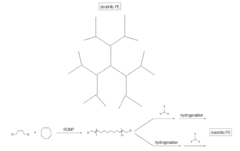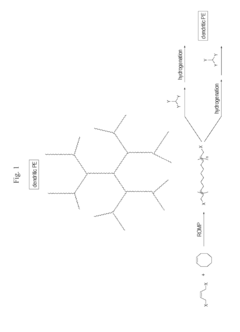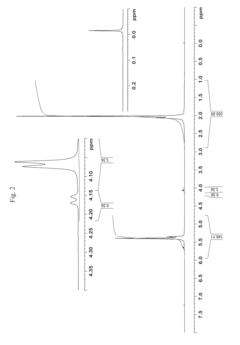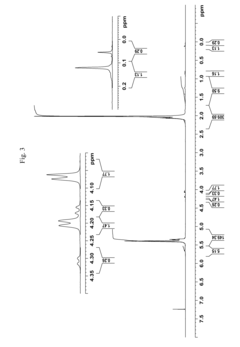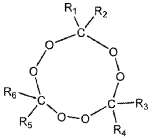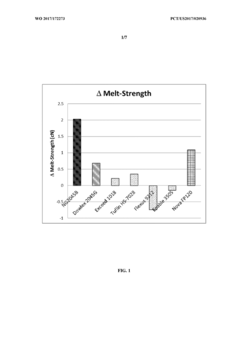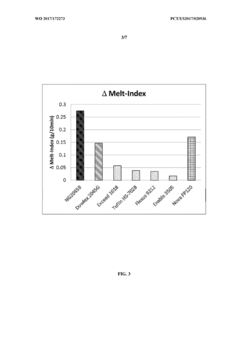How to Increase LDPE's Usability in Manufacturing?
JUN 30, 20259 MIN READ
Generate Your Research Report Instantly with AI Agent
Patsnap Eureka helps you evaluate technical feasibility & market potential.
LDPE Manufacturing Evolution and Objectives
Low-density polyethylene (LDPE) has been a cornerstone in the manufacturing industry since its inception in the 1930s. The evolution of LDPE manufacturing has been driven by the need for more efficient production processes and improved material properties. Initially, LDPE was produced using high-pressure tubular reactors, which limited production capacity and material quality.
As technology advanced, the introduction of autoclave reactors in the 1950s marked a significant milestone in LDPE manufacturing. This innovation allowed for better control over the polymerization process, resulting in more consistent product quality and increased production efficiency. The subsequent decades saw further refinements in reactor design and process control, leading to the development of modern high-pressure tubular reactors that offer superior heat transfer and mixing capabilities.
The objectives of LDPE manufacturing have evolved in tandem with market demands and environmental concerns. Early goals focused primarily on increasing production capacity and reducing costs. However, as the industry matured, objectives shifted towards enhancing material properties, such as improved strength, flexibility, and barrier characteristics. This evolution was driven by the expanding applications of LDPE in various sectors, including packaging, agriculture, and consumer goods.
In recent years, sustainability has become a paramount objective in LDPE manufacturing. The industry is now focused on developing more energy-efficient production processes, reducing carbon footprint, and exploring bio-based feedstocks. Additionally, there is a growing emphasis on improving the recyclability of LDPE products to address environmental concerns and meet regulatory requirements.
The current landscape of LDPE manufacturing is characterized by a push towards smart manufacturing and Industry 4.0 principles. This includes the integration of advanced process control systems, real-time monitoring, and predictive maintenance technologies. These innovations aim to optimize production efficiency, minimize waste, and ensure consistent product quality.
Looking ahead, the objectives for LDPE manufacturing are multifaceted. There is a continued drive to enhance material properties, particularly in terms of strength-to-weight ratio and barrier performance. This is crucial for expanding LDPE's usability in high-performance applications. Simultaneously, there is a focus on developing more sustainable production methods, including the use of renewable energy sources and the exploration of chemical recycling technologies to create a circular economy for LDPE products.
In conclusion, the evolution of LDPE manufacturing has been marked by continuous technological advancements and shifting objectives. From its humble beginnings to its current status as a versatile and widely used material, LDPE production has adapted to meet changing industrial needs and environmental considerations. The future of LDPE manufacturing will likely be shaped by the dual imperatives of enhancing material performance and achieving greater sustainability.
As technology advanced, the introduction of autoclave reactors in the 1950s marked a significant milestone in LDPE manufacturing. This innovation allowed for better control over the polymerization process, resulting in more consistent product quality and increased production efficiency. The subsequent decades saw further refinements in reactor design and process control, leading to the development of modern high-pressure tubular reactors that offer superior heat transfer and mixing capabilities.
The objectives of LDPE manufacturing have evolved in tandem with market demands and environmental concerns. Early goals focused primarily on increasing production capacity and reducing costs. However, as the industry matured, objectives shifted towards enhancing material properties, such as improved strength, flexibility, and barrier characteristics. This evolution was driven by the expanding applications of LDPE in various sectors, including packaging, agriculture, and consumer goods.
In recent years, sustainability has become a paramount objective in LDPE manufacturing. The industry is now focused on developing more energy-efficient production processes, reducing carbon footprint, and exploring bio-based feedstocks. Additionally, there is a growing emphasis on improving the recyclability of LDPE products to address environmental concerns and meet regulatory requirements.
The current landscape of LDPE manufacturing is characterized by a push towards smart manufacturing and Industry 4.0 principles. This includes the integration of advanced process control systems, real-time monitoring, and predictive maintenance technologies. These innovations aim to optimize production efficiency, minimize waste, and ensure consistent product quality.
Looking ahead, the objectives for LDPE manufacturing are multifaceted. There is a continued drive to enhance material properties, particularly in terms of strength-to-weight ratio and barrier performance. This is crucial for expanding LDPE's usability in high-performance applications. Simultaneously, there is a focus on developing more sustainable production methods, including the use of renewable energy sources and the exploration of chemical recycling technologies to create a circular economy for LDPE products.
In conclusion, the evolution of LDPE manufacturing has been marked by continuous technological advancements and shifting objectives. From its humble beginnings to its current status as a versatile and widely used material, LDPE production has adapted to meet changing industrial needs and environmental considerations. The future of LDPE manufacturing will likely be shaped by the dual imperatives of enhancing material performance and achieving greater sustainability.
LDPE Market Demand Analysis
The global market for Low-Density Polyethylene (LDPE) has been experiencing steady growth, driven by its versatile properties and wide range of applications in manufacturing. LDPE's demand is primarily fueled by its use in packaging, construction, and agriculture sectors. The packaging industry, in particular, has been a significant contributor to LDPE's market growth, with increasing demand for flexible packaging solutions in food and beverage, personal care, and pharmaceutical industries.
In recent years, the LDPE market has witnessed a shift towards sustainable and eco-friendly alternatives, prompting manufacturers to focus on developing recyclable and biodegradable LDPE products. This trend is expected to continue shaping the market landscape, as consumers and regulatory bodies push for more environmentally responsible packaging solutions.
The construction industry has also been a key driver of LDPE demand, particularly in developing economies where infrastructure development is booming. LDPE's applications in construction include vapor barriers, geomembranes, and insulation materials, contributing to its growing market share in this sector.
Agriculture represents another significant market for LDPE, with applications in greenhouse films, mulch films, and silage bags. The increasing adoption of modern farming techniques and the need for improved crop yields have bolstered the demand for LDPE products in this sector.
Despite the positive growth trajectory, the LDPE market faces challenges from competing materials such as High-Density Polyethylene (HDPE) and Linear Low-Density Polyethylene (LLDPE). These materials offer superior mechanical properties in certain applications, potentially limiting LDPE's market expansion in specific segments.
The automotive industry presents a potential growth area for LDPE, with increasing use in interior components, wire insulation, and fuel systems. As vehicle manufacturers strive for lighter and more fuel-efficient designs, LDPE's low weight and durability make it an attractive option for various automotive applications.
Geographically, Asia-Pacific remains the largest market for LDPE, driven by rapid industrialization, population growth, and increasing disposable incomes in countries like China and India. North America and Europe follow, with mature markets focusing on innovation and sustainability to maintain their market positions.
To increase LDPE's usability in manufacturing, industry players are investing in research and development to enhance its properties and expand its application range. Efforts are being made to improve LDPE's strength, barrier properties, and processability, making it more competitive against alternative materials and opening up new market opportunities.
In recent years, the LDPE market has witnessed a shift towards sustainable and eco-friendly alternatives, prompting manufacturers to focus on developing recyclable and biodegradable LDPE products. This trend is expected to continue shaping the market landscape, as consumers and regulatory bodies push for more environmentally responsible packaging solutions.
The construction industry has also been a key driver of LDPE demand, particularly in developing economies where infrastructure development is booming. LDPE's applications in construction include vapor barriers, geomembranes, and insulation materials, contributing to its growing market share in this sector.
Agriculture represents another significant market for LDPE, with applications in greenhouse films, mulch films, and silage bags. The increasing adoption of modern farming techniques and the need for improved crop yields have bolstered the demand for LDPE products in this sector.
Despite the positive growth trajectory, the LDPE market faces challenges from competing materials such as High-Density Polyethylene (HDPE) and Linear Low-Density Polyethylene (LLDPE). These materials offer superior mechanical properties in certain applications, potentially limiting LDPE's market expansion in specific segments.
The automotive industry presents a potential growth area for LDPE, with increasing use in interior components, wire insulation, and fuel systems. As vehicle manufacturers strive for lighter and more fuel-efficient designs, LDPE's low weight and durability make it an attractive option for various automotive applications.
Geographically, Asia-Pacific remains the largest market for LDPE, driven by rapid industrialization, population growth, and increasing disposable incomes in countries like China and India. North America and Europe follow, with mature markets focusing on innovation and sustainability to maintain their market positions.
To increase LDPE's usability in manufacturing, industry players are investing in research and development to enhance its properties and expand its application range. Efforts are being made to improve LDPE's strength, barrier properties, and processability, making it more competitive against alternative materials and opening up new market opportunities.
LDPE Technical Challenges
Low-density polyethylene (LDPE) faces several technical challenges that limit its usability in manufacturing processes. One of the primary issues is its relatively low melting point, which restricts its application in high-temperature environments. This characteristic makes LDPE susceptible to deformation and loss of structural integrity when exposed to elevated temperatures, limiting its use in certain industrial applications.
Another significant challenge is LDPE's poor resistance to chemicals and solvents. This vulnerability makes it unsuitable for use in environments where it may come into contact with aggressive substances, potentially leading to degradation or failure of the material. The limited chemical resistance also poses difficulties in cleaning and maintaining LDPE components in manufacturing settings.
LDPE's mechanical properties present additional hurdles. Its low tensile strength and relatively poor impact resistance compared to other polymers can result in reduced durability and shorter lifespan of manufactured products. This weakness often necessitates the use of thicker material or reinforcement techniques, which can increase production costs and material usage.
The material's high degree of branching in its molecular structure contributes to its flexibility but also results in lower crystallinity. This characteristic leads to decreased stiffness and hardness, potentially limiting LDPE's applications in scenarios requiring high structural rigidity or load-bearing capabilities.
Processing challenges also exist in LDPE manufacturing. The material's low melt strength can cause difficulties in extrusion processes, particularly in blow molding and film production. This can lead to inconsistencies in product quality and increased production waste, affecting overall manufacturing efficiency.
LDPE's thermal conductivity is relatively low, which can pose challenges in applications requiring heat dissipation or thermal management. This property can limit its use in certain electronic or automotive components where heat transfer is crucial for optimal performance.
Additionally, LDPE exhibits poor barrier properties against gases and moisture. This characteristic restricts its use in packaging applications that require high levels of protection against environmental factors, potentially limiting its market potential in certain sectors of the packaging industry.
The material's tendency to develop static charge can also be problematic in manufacturing environments, potentially attracting dust and contaminants or causing issues in electronic assembly processes. This property necessitates additional treatments or handling precautions, adding complexity to manufacturing processes.
Addressing these technical challenges is crucial for expanding LDPE's usability in manufacturing. Innovations in material science, such as the development of new additives or processing techniques, could potentially mitigate some of these limitations and open up new applications for LDPE in various industrial sectors.
Another significant challenge is LDPE's poor resistance to chemicals and solvents. This vulnerability makes it unsuitable for use in environments where it may come into contact with aggressive substances, potentially leading to degradation or failure of the material. The limited chemical resistance also poses difficulties in cleaning and maintaining LDPE components in manufacturing settings.
LDPE's mechanical properties present additional hurdles. Its low tensile strength and relatively poor impact resistance compared to other polymers can result in reduced durability and shorter lifespan of manufactured products. This weakness often necessitates the use of thicker material or reinforcement techniques, which can increase production costs and material usage.
The material's high degree of branching in its molecular structure contributes to its flexibility but also results in lower crystallinity. This characteristic leads to decreased stiffness and hardness, potentially limiting LDPE's applications in scenarios requiring high structural rigidity or load-bearing capabilities.
Processing challenges also exist in LDPE manufacturing. The material's low melt strength can cause difficulties in extrusion processes, particularly in blow molding and film production. This can lead to inconsistencies in product quality and increased production waste, affecting overall manufacturing efficiency.
LDPE's thermal conductivity is relatively low, which can pose challenges in applications requiring heat dissipation or thermal management. This property can limit its use in certain electronic or automotive components where heat transfer is crucial for optimal performance.
Additionally, LDPE exhibits poor barrier properties against gases and moisture. This characteristic restricts its use in packaging applications that require high levels of protection against environmental factors, potentially limiting its market potential in certain sectors of the packaging industry.
The material's tendency to develop static charge can also be problematic in manufacturing environments, potentially attracting dust and contaminants or causing issues in electronic assembly processes. This property necessitates additional treatments or handling precautions, adding complexity to manufacturing processes.
Addressing these technical challenges is crucial for expanding LDPE's usability in manufacturing. Innovations in material science, such as the development of new additives or processing techniques, could potentially mitigate some of these limitations and open up new applications for LDPE in various industrial sectors.
Current LDPE Enhancement Techniques
01 Packaging applications
LDPE is widely used in packaging applications due to its flexibility, transparency, and moisture resistance. It is commonly used for producing plastic bags, food packaging films, and shrink wraps. The material's low density and good sealing properties make it ideal for these applications, providing effective protection for various products.- Packaging applications: LDPE is widely used in packaging applications due to its flexibility, transparency, and moisture resistance. It is commonly used for producing plastic bags, food packaging films, and shrink wraps. The material's low density and good sealing properties make it ideal for these purposes.
- Agricultural uses: LDPE finds significant applications in agriculture, particularly in the production of greenhouse films, mulch films, and irrigation pipes. Its durability, UV resistance, and ability to retain moisture make it suitable for various agricultural purposes, enhancing crop yield and reducing water consumption.
- Construction and insulation: In the construction industry, LDPE is used for vapor barriers, geomembranes, and insulation materials. Its low thermal conductivity and water resistance properties make it an excellent choice for these applications, improving energy efficiency in buildings and infrastructure projects.
- Medical and pharmaceutical applications: LDPE is utilized in various medical and pharmaceutical products due to its chemical inertness and biocompatibility. It is commonly used in the production of medical packaging, disposable syringes, and pharmaceutical containers, ensuring the safety and integrity of medical supplies and drugs.
- Recycling and sustainability: There is a growing focus on improving the recyclability and sustainability of LDPE products. Research and development efforts are directed towards enhancing the material's recycling processes, developing bio-based alternatives, and creating more environmentally friendly LDPE formulations to address environmental concerns associated with plastic waste.
02 Agricultural uses
LDPE finds significant applications in agriculture, particularly in the production of greenhouse films, mulch films, and irrigation pipes. Its durability, UV resistance, and ability to retain moisture make it suitable for these outdoor applications. LDPE films can help in controlling soil temperature, reducing weed growth, and improving crop yields.Expand Specific Solutions03 Industrial applications
In industrial settings, LDPE is used for various purposes such as wire and cable insulation, geomembranes, and industrial containers. Its electrical insulation properties, chemical resistance, and flexibility make it suitable for these applications. LDPE can also be used in the production of industrial liners and protective coatings.Expand Specific Solutions04 Consumer goods
LDPE is extensively used in the production of consumer goods such as squeeze bottles, toys, and household items. Its flexibility, impact resistance, and ease of processing make it an ideal material for these products. LDPE's non-toxic nature also makes it suitable for food contact applications and children's products.Expand Specific Solutions05 Recycling and sustainability
LDPE's recyclability contributes to its usability in sustainable applications. It can be recycled into various products, reducing environmental impact. Efforts are being made to improve LDPE recycling processes and develop more sustainable alternatives, such as bio-based LDPE, to address environmental concerns associated with plastic use.Expand Specific Solutions
Key LDPE Industry Players
The competition landscape for increasing LDPE's usability in manufacturing is characterized by a mature market with established players and ongoing innovation. The global LDPE market is substantial, valued at over $33 billion in 2020, with steady growth projected. Technologically, the field is advanced but continues to evolve, with major companies like Dow Global Technologies, ExxonMobil, and SABIC leading research efforts. These firms, along with others such as LyondellBasell and Chevron Phillips Chemical, are focusing on enhancing LDPE properties and processing techniques to expand its applications. Emerging players from Asia, including Sinopec and LG Chem, are also making significant contributions, intensifying global competition in this mature yet dynamic sector.
Dow Global Technologies LLC
Technical Solution: Dow has developed a novel LDPE resin with enhanced processability and mechanical properties. Their technology involves incorporating long-chain branching into the polymer structure, resulting in improved melt strength and extensibility[1]. This allows for better bubble stability in film blowing processes and increased output rates in extrusion coating applications. Additionally, Dow has implemented a proprietary catalyst system that enables precise control over molecular weight distribution, leading to a wider processing window and improved film optical properties[2]. The company has also focused on developing LDPE grades with enhanced environmental stress crack resistance (ESCR) for demanding packaging applications[3].
Strengths: Improved melt strength, wider processing window, and enhanced ESCR. Weaknesses: Potentially higher production costs and limited compatibility with certain additives.
ExxonMobil Technology & Engineering Co.
Technical Solution: ExxonMobil has developed a proprietary tubular reactor technology for LDPE production, which allows for precise control of molecular architecture. This technology enables the production of LDPE with a tailored balance of long-chain branching and short-chain branching, resulting in improved processability and mechanical properties[4]. The company has also introduced a new catalyst system that enhances the thermal stability of LDPE, making it suitable for high-temperature applications[5]. Furthermore, ExxonMobil has developed a range of LDPE grades with improved clarity and gloss for packaging applications, achieved through advanced polymer design and optimized cooling processes[6].
Strengths: Precise control of molecular architecture, improved thermal stability, and enhanced optical properties. Weaknesses: Higher production costs and potential limitations in certain specialty applications.
LDPE Property Modification Innovations
Process for making dendritic polyolefins from telechelic polycyclic olefins
PatentInactiveUS20130172493A1
Innovation
- The synthesis of dendritic polyethylenes through ring opening metathesis polymerization of cyclic olefins with bi-functional alkene chain terminating agents, followed by reaction with multifunctional coupling agents, to produce telechelic hydrocarbon polymers that are then reacted with trifunctional or tetrafunctional coupling agents to create dendritic structures, which can be used as additives in conventional polyethylenes.
Modified polyethylene resins and method for making the same
PatentWO2017172273A1
Innovation
- A method involving a first polyethylene resin with specific density and melt index ranges, combined with a masterbatch composition containing a free radical generator and a second polyethylene resin, to form a modified polyethylene resin with increased melt strength and low shear viscosity, achieved by reacting the first resin with the masterbatch composition.
LDPE Sustainability Considerations
Sustainability considerations play a crucial role in the increased usability of Low-Density Polyethylene (LDPE) in manufacturing. As environmental concerns continue to grow, the plastics industry faces mounting pressure to adopt more sustainable practices. LDPE, being one of the most widely used plastics, is at the forefront of this sustainability challenge.
One of the primary sustainability considerations for LDPE is its recyclability. While LDPE is technically recyclable, the process is often complicated by contamination and the presence of additives. Improving the recyclability of LDPE products can significantly enhance its usability in manufacturing. This involves developing better sorting and cleaning technologies, as well as designing products with recycling in mind from the outset.
The use of bio-based feedstocks for LDPE production is another important sustainability consideration. Traditional LDPE is derived from fossil fuels, contributing to carbon emissions. By transitioning to renewable, bio-based sources, manufacturers can reduce the carbon footprint of LDPE production. This shift not only addresses environmental concerns but also helps meet the growing consumer demand for more sustainable products.
Energy efficiency in LDPE manufacturing is a critical factor in improving its sustainability profile. Innovations in production processes that reduce energy consumption can significantly lower the environmental impact of LDPE. This includes optimizing reactor designs, improving heat recovery systems, and implementing more efficient catalysts.
The end-of-life management of LDPE products is another key sustainability consideration. Developing biodegradable or compostable versions of LDPE could help address the issue of plastic waste accumulation. However, this approach must be balanced with the material's performance requirements in various applications.
Reducing the overall use of LDPE through material efficiency and product redesign is also an important sustainability strategy. This can involve creating thinner films without compromising performance, or finding alternative materials for certain applications where LDPE is not essential.
The circular economy concept is increasingly relevant to LDPE sustainability. This involves not just recycling, but also reusing and repurposing LDPE products. Implementing take-back programs and developing new applications for recycled LDPE can help close the loop in the material's lifecycle.
Lastly, the development of advanced recycling technologies, such as chemical recycling, offers promising solutions for LDPE sustainability. These technologies can break down LDPE into its chemical components, allowing for the creation of new, high-quality plastics from recycled materials.
One of the primary sustainability considerations for LDPE is its recyclability. While LDPE is technically recyclable, the process is often complicated by contamination and the presence of additives. Improving the recyclability of LDPE products can significantly enhance its usability in manufacturing. This involves developing better sorting and cleaning technologies, as well as designing products with recycling in mind from the outset.
The use of bio-based feedstocks for LDPE production is another important sustainability consideration. Traditional LDPE is derived from fossil fuels, contributing to carbon emissions. By transitioning to renewable, bio-based sources, manufacturers can reduce the carbon footprint of LDPE production. This shift not only addresses environmental concerns but also helps meet the growing consumer demand for more sustainable products.
Energy efficiency in LDPE manufacturing is a critical factor in improving its sustainability profile. Innovations in production processes that reduce energy consumption can significantly lower the environmental impact of LDPE. This includes optimizing reactor designs, improving heat recovery systems, and implementing more efficient catalysts.
The end-of-life management of LDPE products is another key sustainability consideration. Developing biodegradable or compostable versions of LDPE could help address the issue of plastic waste accumulation. However, this approach must be balanced with the material's performance requirements in various applications.
Reducing the overall use of LDPE through material efficiency and product redesign is also an important sustainability strategy. This can involve creating thinner films without compromising performance, or finding alternative materials for certain applications where LDPE is not essential.
The circular economy concept is increasingly relevant to LDPE sustainability. This involves not just recycling, but also reusing and repurposing LDPE products. Implementing take-back programs and developing new applications for recycled LDPE can help close the loop in the material's lifecycle.
Lastly, the development of advanced recycling technologies, such as chemical recycling, offers promising solutions for LDPE sustainability. These technologies can break down LDPE into its chemical components, allowing for the creation of new, high-quality plastics from recycled materials.
LDPE Regulatory Compliance
Regulatory compliance is a critical aspect of increasing LDPE's usability in manufacturing. As the demand for LDPE in various industries grows, manufacturers must navigate a complex landscape of regulations to ensure their products meet safety and environmental standards.
In the United States, the Food and Drug Administration (FDA) plays a crucial role in regulating LDPE used in food packaging and medical devices. Manufacturers must comply with FDA regulations outlined in 21 CFR 177.1520, which specifies the requirements for olefin polymers intended for food contact applications. This includes limitations on extractables and specific migration limits for certain substances.
The European Union has implemented stringent regulations through the Registration, Evaluation, Authorization, and Restriction of Chemicals (REACH) framework. LDPE manufacturers and importers must register their substances with the European Chemicals Agency (ECHA) and provide detailed information on the properties and potential risks associated with their products.
Environmental regulations also significantly impact LDPE manufacturing and usage. Many countries have implemented plastic waste reduction initiatives, which may affect the production and disposal of LDPE products. For instance, the EU's Single-Use Plastics Directive aims to reduce the environmental impact of certain plastic products, including those made from LDPE.
To increase LDPE's usability in manufacturing while maintaining regulatory compliance, companies must invest in research and development to create innovative formulations that meet or exceed regulatory requirements. This may involve developing LDPE grades with improved mechanical properties, enhanced recyclability, or reduced environmental impact.
Manufacturers should also implement robust quality control systems to ensure consistent compliance with regulatory standards. This includes regular testing of raw materials, monitoring of production processes, and thorough documentation of compliance efforts.
Staying informed about evolving regulations is crucial for maintaining compliance and identifying new opportunities for LDPE applications. Companies should establish dedicated teams to monitor regulatory changes and assess their potential impact on product development and manufacturing processes.
Collaboration with regulatory bodies and industry associations can help manufacturers stay ahead of compliance challenges. Participating in industry working groups and contributing to the development of new standards can provide valuable insights and influence the regulatory landscape in favor of increased LDPE usability.
In the United States, the Food and Drug Administration (FDA) plays a crucial role in regulating LDPE used in food packaging and medical devices. Manufacturers must comply with FDA regulations outlined in 21 CFR 177.1520, which specifies the requirements for olefin polymers intended for food contact applications. This includes limitations on extractables and specific migration limits for certain substances.
The European Union has implemented stringent regulations through the Registration, Evaluation, Authorization, and Restriction of Chemicals (REACH) framework. LDPE manufacturers and importers must register their substances with the European Chemicals Agency (ECHA) and provide detailed information on the properties and potential risks associated with their products.
Environmental regulations also significantly impact LDPE manufacturing and usage. Many countries have implemented plastic waste reduction initiatives, which may affect the production and disposal of LDPE products. For instance, the EU's Single-Use Plastics Directive aims to reduce the environmental impact of certain plastic products, including those made from LDPE.
To increase LDPE's usability in manufacturing while maintaining regulatory compliance, companies must invest in research and development to create innovative formulations that meet or exceed regulatory requirements. This may involve developing LDPE grades with improved mechanical properties, enhanced recyclability, or reduced environmental impact.
Manufacturers should also implement robust quality control systems to ensure consistent compliance with regulatory standards. This includes regular testing of raw materials, monitoring of production processes, and thorough documentation of compliance efforts.
Staying informed about evolving regulations is crucial for maintaining compliance and identifying new opportunities for LDPE applications. Companies should establish dedicated teams to monitor regulatory changes and assess their potential impact on product development and manufacturing processes.
Collaboration with regulatory bodies and industry associations can help manufacturers stay ahead of compliance challenges. Participating in industry working groups and contributing to the development of new standards can provide valuable insights and influence the regulatory landscape in favor of increased LDPE usability.
Unlock deeper insights with Patsnap Eureka Quick Research — get a full tech report to explore trends and direct your research. Try now!
Generate Your Research Report Instantly with AI Agent
Supercharge your innovation with Patsnap Eureka AI Agent Platform!
